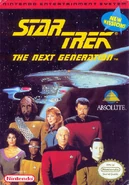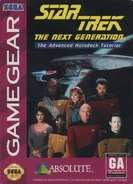StalwartUK (talk | contribs) mNo edit summary |
|||
| (3 intermediate revisions by one other user not shown) | |||
| Line 11: | Line 11: | ||
| rating = {{game ratings|VRC=ga}} |
| rating = {{game ratings|VRC=ga}} |
||
| Genres = Simulation |
| Genres = Simulation |
||
| − | | Reference = {{ASIN|B00005C7UK}} (Game Boy)<br/>{{ASIN|B00004SVUZ}} (NES)<br/>{{ASIN|B00002ST05}} (Game Gear) |
+ | | Reference = {{ASIN|B00005C7UK}} (US Game Boy)<br/>{{ASIN|B00004SVUZ}} (US NES)<br/>{{ASIN|B00002ST05}} (US Game Gear)<br/>{{ASIN|B005697PMG|DE}} (DE Game Boy) |
}} |
}} |
||
'''''Star Trek: The Next Generation''''' was a [[games|video game]] released in {{y|1993}} for the Nintendo Entertainment System, Game Boy, and Sega Game Gear. It was developed and published by [[Absolute Entertainment]]. The Sega Game Gear version, released in {{y|1994}}, was titled '''''Star Trek: The Next Generation - The Advanced Holodeck Tutorial'''''. |
'''''Star Trek: The Next Generation''''' was a [[games|video game]] released in {{y|1993}} for the Nintendo Entertainment System, Game Boy, and Sega Game Gear. It was developed and published by [[Absolute Entertainment]]. The Sega Game Gear version, released in {{y|1994}}, was titled '''''Star Trek: The Next Generation - The Advanced Holodeck Tutorial'''''. |
||
| Line 30: | Line 30: | ||
== Credits == |
== Credits == |
||
| ⚫ | |||
| − | ;Concept: |
||
| − | * Mark Beardsley |
+ | *Design: Mark Beardsley, Gregory A. Faccone |
| − | * Gregory A. Faccone |
+ | *Graphics: Gregory A. Faccone, Daniel Peters |
| + | *Programming: Mark Beardsley, Roger Amidon |
||
| − | ;Design: |
||
| ⚫ | |||
| − | * Mark Beardsley |
||
| ⚫ | |||
| ⚫ | |||
| ⚫ | |||
| − | ;Graphics: |
||
| ⚫ | |||
| − | * Gregory A. Faccone |
||
| ⚫ | |||
| − | * Daniel Peters |
||
| + | *Special Thanks: Barry Marx, Tak Lau, Ross Harris |
||
| − | ;Programming: |
||
| − | * Mark Beardsley |
||
| − | * Roger Amidon |
||
| ⚫ | |||
| − | * Henry C. Will IV |
||
| ⚫ | |||
| − | * Mark Van Hecke |
||
| ⚫ | |||
| − | * Henry C. Will IV |
||
| ⚫ | |||
| − | * Carol Albert |
||
| − | ;Producer: |
||
| ⚫ | |||
| − | ;Special Thanks: |
||
| − | * Barry Marx |
||
| − | * Tak Lau |
||
| − | * Ross Harris |
||
==Gallery== |
==Gallery== |
||
Revision as of 19:39, 20 March 2013
Template:Realworld Star Trek: The Next Generation was a video game released in 1993 for the Nintendo Entertainment System, Game Boy, and Sega Game Gear. It was developed and published by Absolute Entertainment. The Sega Game Gear version, released in 1994, was titled Star Trek: The Next Generation - The Advanced Holodeck Tutorial.
Summary
You are a cadet at Starfleet Academy and must spend time in the Academy's starship combat simulator. In place of Jean-Luc Picard, cadets take the role of captain of the USS Enterprise-D and then must turn to different crew members to access different functions of the ship, as well as take direct control of maneuvering and weapons fire for combat, to complete a series of missions.
Gameplay
An example of the screen in which you consult one of your officers (NES)
Gameplay is divided into missions. Players must thwart invasions, battle craft ranging from Talarian warships to Borg cubes, and defend space stations from destruction by asteroids. Although Starfleet regulation requires a diplomatic solution be attempted prior to engaging in combat, this appears to be purely a battle simulator as no ship-to-ship communication seems to be possible.
Players must call on different crew members to accomplish certain actions; Data for navigation and operations, Worf for tactical, La Forge for engineering, O'Brien for transporter systems, and Riker for mission status.
Once systems are ready and the ship is at battle stations, the player takes control of the ship and must navigate a virtual 3D space to battle the enemy and complete the mission assigned. Phasers and photon torpedoes are fired and aimed manually. As can be imagined, photon torpedoes are more destructive
Screen shot showing the mini-game used to divert power to different systems (NES)
Mini-games are used to make certain ship functions more challenging to modify of employ. For example, re-routing power to different systems is accomplished by diverting power (represented by blips of light) through tangled power relays. Transporting is done by hovering a cursor over the object to be beamed. You achieving orbit by navigating the ship through a series of squares.
Credits
- Concept: Mark Beardsley, Gregory A. Faccone
- Design: Mark Beardsley, Gregory A. Faccone
- Graphics: Gregory A. Faccone, Daniel Peters
- Programming: Mark Beardsley, Roger Amidon
- Additional Programming: Henry C. Will IV
- Musical Arrangement: Mark Van Hecke
- Technical Direction: Henry C. Will IV
- Creative Director: Carol Albert
- Producer: Dan Kitchen
- Special Thanks: Barry Marx, Tak Lau, Ross Harris


